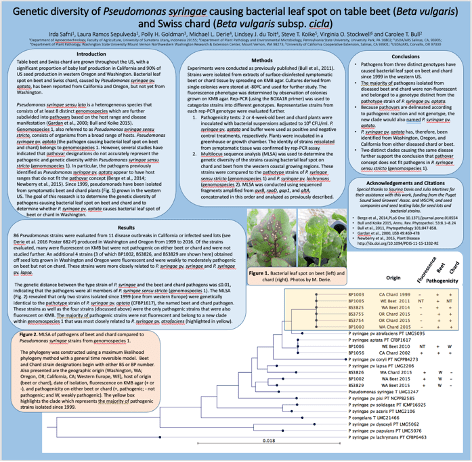Pseudomonas syrinage causing leaf spot and blight on Chenopods
When researchers who have not worked with pathogens of these crops think about leaf spots and blights on Chenopods caused by Pseudomonas syringae, they assume that the pathogen causing these diseases is Pseudomonas syringae pv. aptata because this pathogen has been associated with spot diseases of sugar beet for over 100 years.
Pseudomonas syringae pv. aptata was first called Bacterium aptatum by Nellie A. Brown and Clara O. Jamieson in 1913 in their description of the pathogen causing leaf spot disease of sugar beet from a field in Garland Utah (Brown and Jamieson, 2013). Eventually, it was renamed Pseudomonas aptata (Stevens, 1925) and later became Pseudomonas syringae pv. aptata when many plant pathogenic Pseudomonas species were collapsed into P. syringae (Young et al., 1978). This pathogen was implicated in leaf spot diseases in both sugar and table beet as well as Swiss Chard.
Our recent and ongoing work demonstrated that the pathogens causing these diseases are a heterogenous complex of organisms from Pseudomonas syringae sensu stricto also designated as genomospecies 1 or phylogroup 2 (Safni et al., 2016). Some of the strains being isolated from seed are fluorescent and genotypically similar to Pseudomonas syringae pv. aptata but others are not fluorescent and are more closely related to P. syriange pv. atrofaciens. We are also identifying differences in plant reactions to the various beet and chard genotypes.
Genetic diversity of Pseudomonas syringae causing bacterial leaf spot on table beet (Beta vulgaris) and Swiss chard (Beta vulgaris subsp. cicla). Safni, I., Sepulveda, L.R., Goldman, P.H., Derie, M.L., du Toit, LJ., Koike, S.T., Stockwell, V.O., and Bull, C.T., 2016. APS National Meeting, July 30 – August 4, 2016, Tampa, Florida.



